By Rick VanSickle
Few Ontario wines have the history and pedigree as Chateau des Charmes’ flagship red, Equuleus.
Also in this Niagara Wine Report: Lailey Estate winery, Two Sisters among three Canadian Chardonnays awarded distinction of gold medals from the Chardonnay du Monde wine competition in Burgundy.
It first appeared as Equuleus in 1995, but the Cabernet Sauvignon dominant blend, sourced from the Paul Bosc Estate Vineyard, has history back to the late 1980s. It was a head-turner back in those early years and it continues to turn heads today as one of Niagara’s most collectible and long-lived red wines. I just tasted a bottle that proves it beyond a shadow of doubt!
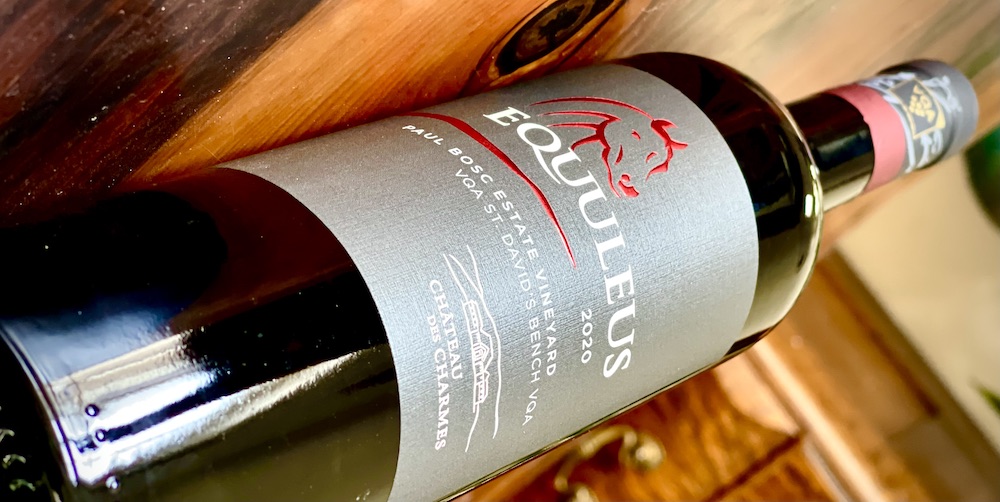
It may not get the glitzy release buzz it once did, with vertical tastings and a mad dash to grab the newly released vintages only made in the very best years in Niagara, but it still commands attention for those seeking the best of the Bordeaux variety blends made in the province.
“It is always a combination of factors that make an Equuleus year for us; an extraordinary growing season, optimal phenolic ripeness combined to a lower yield and no less than 18 months of aging in barrels,” explains Chateau des Charmes winemaker Amelie Boury. “There is no compromise on those wines, a true reflection of the work in the vineyard and in the cellar, and what the vintage had to offer.”
The St. David’s Bench winery has just released the 2020 vintage at the chateau, the first since the 2016 vintage.
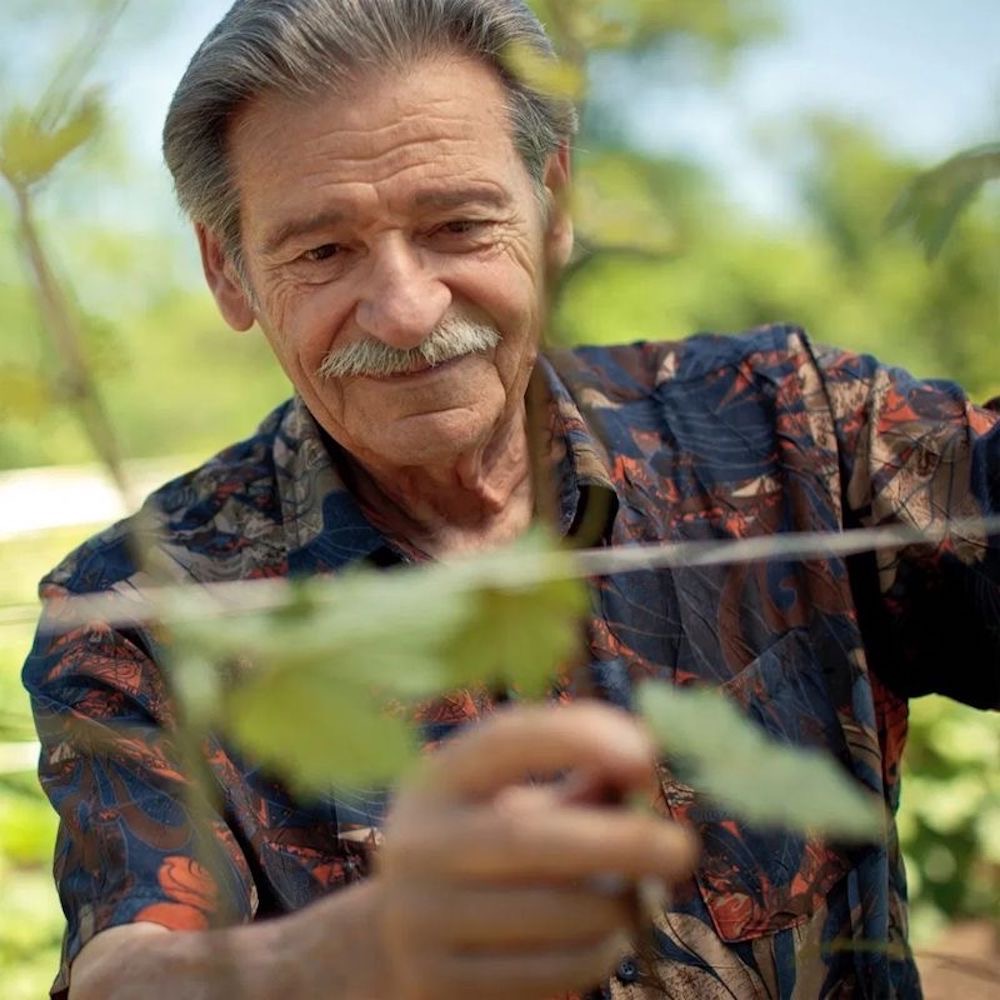
Equuleus is a classically styled blend of 50% Cabernet Sauvignon, 25% Cabernet Franc and 25% Merlot from a coveted block in the Paul Bosc Vineyard planted in 1983 and 1984 with the first harvest in 1988. To be considered an Equuleus year each of the three grape varieties must have achieved at least 23.5º Brix at harvest. Aging is for 16 months in 1/3 new French oak, 2/3 in used French oak then the blend rests in French oak casks for several months.
The name Equuleus comes from the “Little Horse” constellation, best seen when it rises in the night sky every September, the traditional start of the estate’s harvest. This equine symbol celebrates patriarch Paul Bosc’s other passion — Egyptian Arabian horses which are stabled at the Paul Bosc Estate, the Bosc family’s home vineyard.
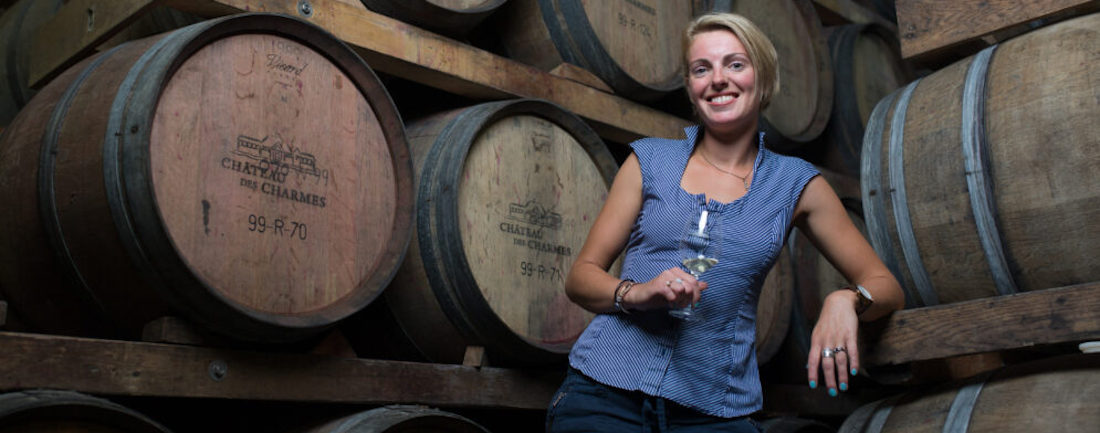
The vineyard block where Equuleus is born has proven to be a sweet spot in Niagara for Bordeaux varietals. The two sides of the block are bounded by a stand of trees which act as a wind block which helps drive up the temperatures a few degrees, as compared to the rest of the vineyard. This, combined with careful yield management, results in fully mature grapes at harvest, especially during warm years such as 2020, 2016, 2012, 2010, 2007 and so on. An added bonus is the extra compost available from the stalls which is routinely spread among only these vines.
Since the official first vintage of Equuleus in 1995, and even before that when it was simply called Cabernet, the blend has been dominated by Cabernet Sauvignon. In recent history it has always been a blend of 50% Cab Sauv with equal parts Cabernet Franc and Merlot. Prior to that, it was still Cabernet Sauvignon dominant, but the amounts of Merlot and Cab Franc varied.
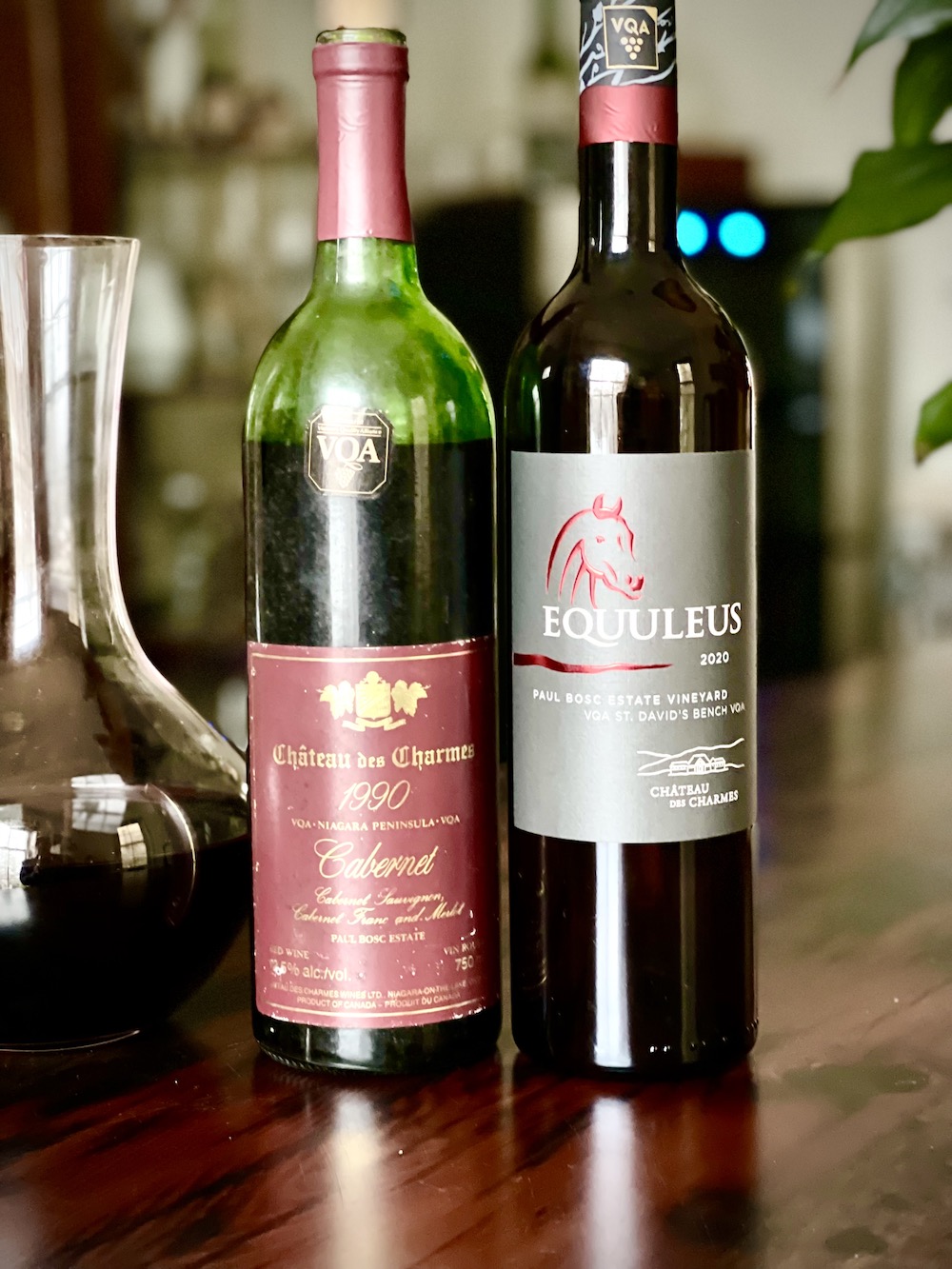
Which brings me to an old dusty bottle of 1990 Chateau des Charmes Cabernet from what was then labelled Paul Bosc Estate, a blend of Cabernet Sauvignon, Cabernet Franc, and Merlot. It had been in my modest cellar for a while, but I did not originally purchase this bottle. It came from a prolific collector of Niagara wines, Paul Nemy, who sought out the best of what Niagara was producing in the 1980s and 1990s. I only have a few of these older bottles left and I thought it would be fun to open the 1990 and compare it to the 2020 Equuleus just released. My expectations were low, as you might expect for a 33-year-old Niagara red wine made in the infancy of the modern wine industry in Ontario.
Now, I don’t know the exact percentages of the grapes in the 1990 bottle, but it’s safe to assume that it is dominated by Cabernet Sauvignon from the Paul Bosc Vineyard, with the other components, the Cab Franc and Merlot, also from that vineyard, as the other estate vineyard, St. David’s Bench, wasn’t planted until 1990.
What is also interesting about the 1990 bottling, it was only two years after the Vintners Quality Alliance (VQA) was established in Ontario. You can see the sticker on the neck of the bottle. VQA was a voluntary organization until 1999 when the VQA Act was passed by the legislature of Ontario, making VQA Ontario the designated wine authority by law.
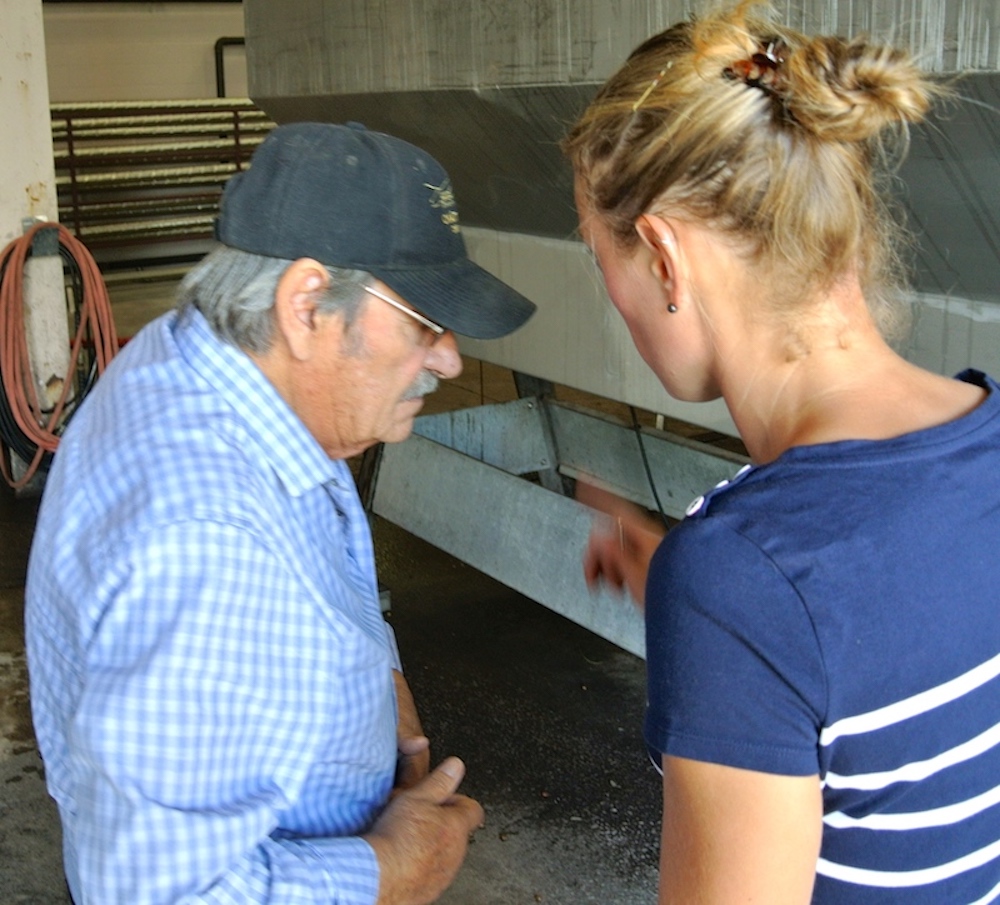
There were 15 participating wineries in 1988 who had signed the initial agreement of goals and purposes and who participated in the decision making of the VQA throughout the process of attaining mandated self-regulation. They were important as the leaders of the movement who had promoted a production model for the Ontario wine industry that was a radical
departure from the status quo, insisting that Ontario could be a producer of quality wines made from vinifera grapes and dedicated themselves to that passion.
Pioneers such as Paul Bosc Sr. and Paul Bosc Jr. of Chateau des Charmes, Karl Kaiser of Inniskillin, and Len Pennachetti of Cave Spring Cellars were part of the group steering Ontario wine out a checkered past to provide a starting point for an industry envisioning a bright future.
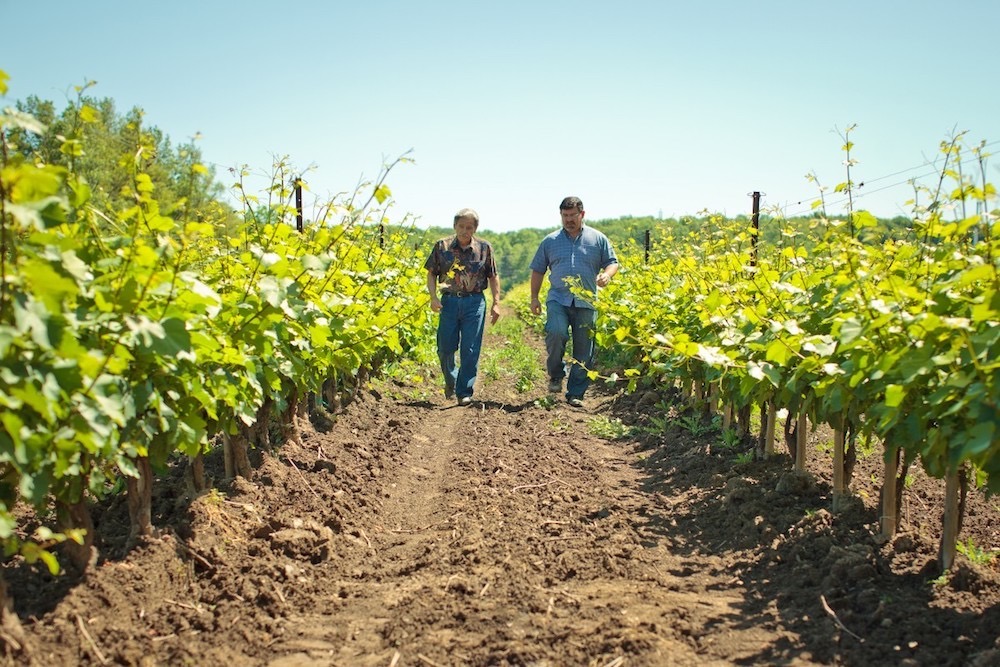
The Boscs and Pennachetti were on the board of directors of the VQA throughout the process and Bosc Sr. served on the technical committee and was instrumental in the formulation of the standards, according to a Ph. D. thesis written by Anna E. Janzen from McMaster University.
The history behind the 1990 Cabernet is cool, but to taste it beside the 2020 Equuleus, was a rare treat that provides insightful context for where the current wine is going. And I must say, it’s headed for a long, beautiful life indeed.
I tasted the 2020 Equuleus after a 12-hour decant and the 1990 Cabernet without decanting (I was worried about it breaking down quickly, which, as it turns out, it did not). I came back to both wines 24 hours later.
Here is what I liked:
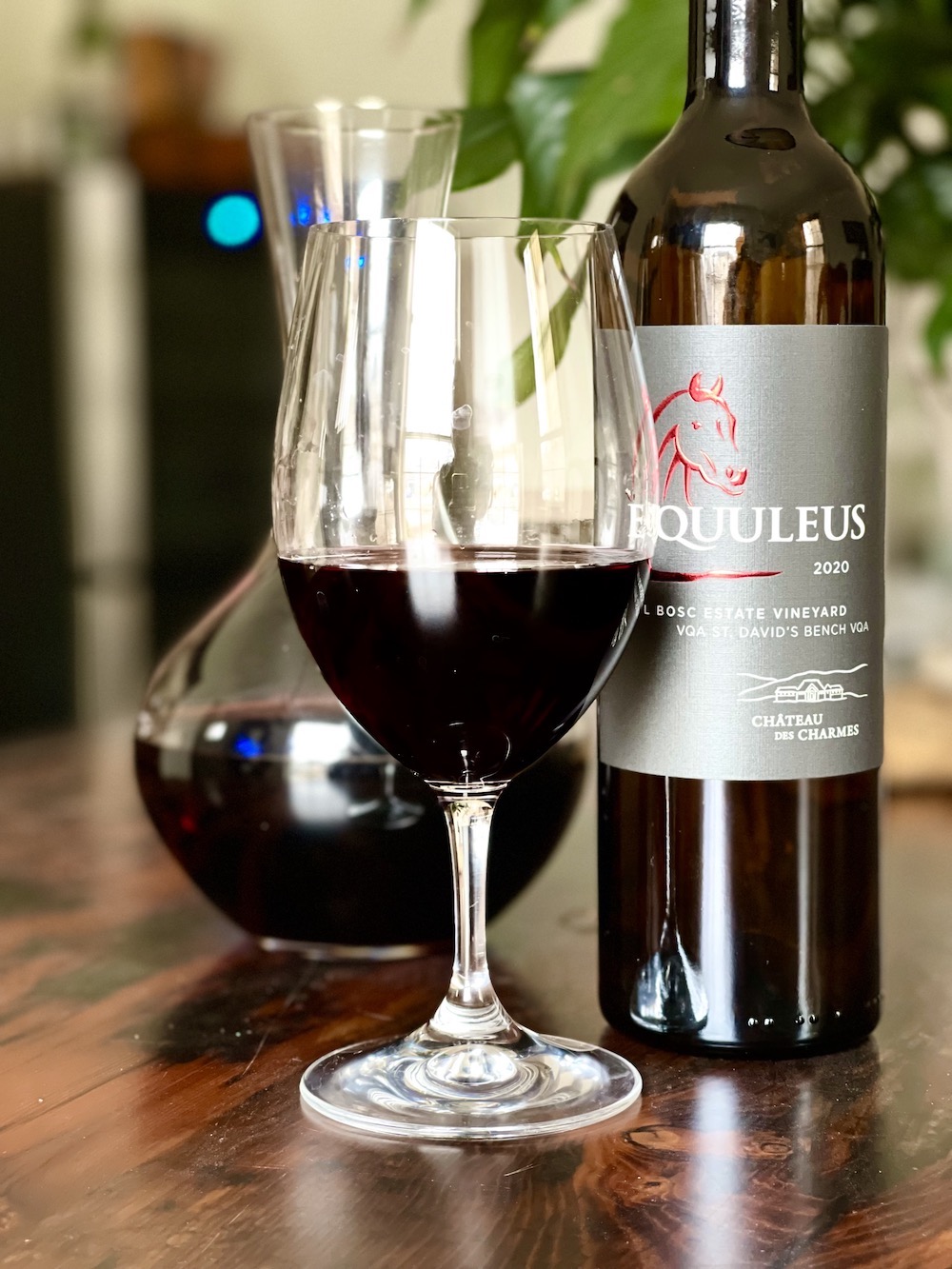
Chateau des Charmes Equuleus 2020 ($60, released at winery, 95 points) — The Paul Bosc Vineyard is located at 1020 York Road (across the street from the chateau). It was planted in 1983 and 1984 with the first harvest in 1988. It consists of 44 acres planted to Chardonnay, Cabernet Franc, Cabernet Sauvignon, Merlot, Pinot Noir, Riesling, and Sauvignon Blanc. The soil is a combination of Smithville clay loam and small pockets of Haldimand clay loam. The blend for the Equuleus is 50% Cabernet Sauvignon, 25% Cabernet Franc and 25% Merlot. The three grape varieties must have achieved at least 23.5º Brix at harvest and is aged for 16 months in 1/3 new French oak, 2/3 in used French oak then the blend rests in French oak casks for several months. I recommend decanting for at least a few hours as you might encounter a faint note of SO2, which dissipates completely with air. Seldom does a Cabernet Sauvignon-based red blend show such a fruit-laden nose as this does. It explodes with ripe blackberries, crème de cassis, cherry-kirsch and dark chocolate that is juicy and forward with subtle earthy notes and oak spices that offer a warm embrace. It is generous, complex, and layered on the palate with a bold profile of saturated dark berries, licorice, dark cherry extract, a hint of eucalypt, rich baking spices, mocha, toasted vanilla bean, caressing tannic structure a long, long finish lifted by electric acidity. This is one beautiful wine that comes with a caveat … to realize its full potential, give it the time it deserves in your cellar. Try a minimum of two years but you will be richly rewarded with 10-15 years of cellaring.
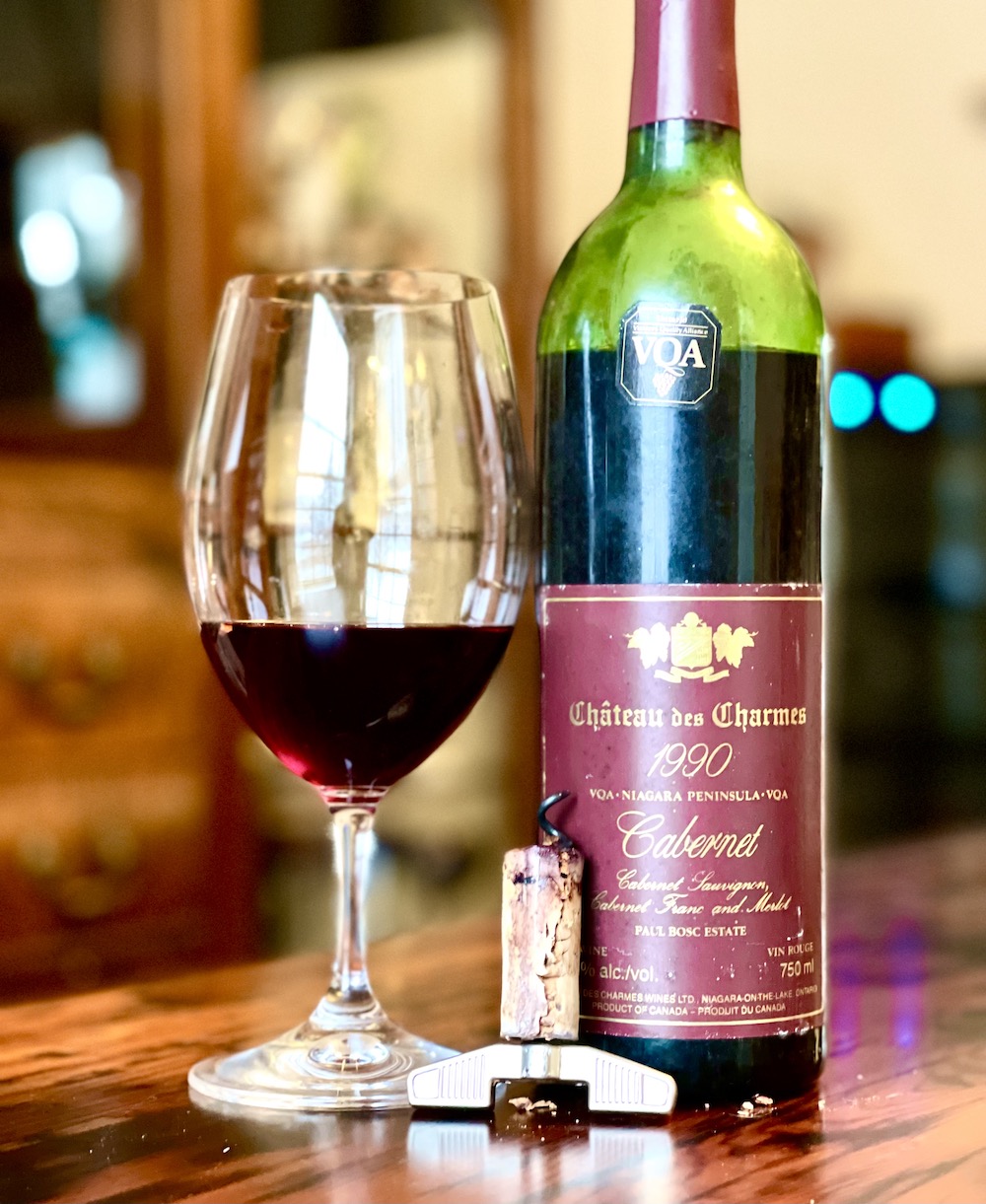
Chateau des Charmes Cabernet 1990 — I have opened a lot of older wines in my time here on this great Earth of ours. I have been blown away, horribly disappointed and somewhere in between many times over. Well-aged wines excite me, but none more than those which have no right to perform at the level of this 1990 Niagara red blend of Cabernet Sauvignon, Merlot and Cabernet Franc, born only two years after VQA (the volunteer group) was established. I could not comprehend what I was smelling after opening the bottle. It had mid-shoulder ullage (not a good sign), but the cork was tightly sealed and was removed without fanfare or breakdown. The wine was brick(ish) but not showing any other signs of its advanced age. And then the fruit emerged — ripe dark berries, kirsch, gushing cassis, plums, and raspberry jam. The spice was fully integrated and was more like a subtle vanilla/caramel accent with just a pinch of woodsy/earthy notes. It all came in wave after wave and grew in intensity the more I swirled it in the glass. “Unbelievable” was the note I wrote in my tasting book after the first sip. Such incredibly ripe fruit that was still very much alive and giving pleasure 33 years later. Think ripe summer red berries, cassis, blackcurrant jam, and anise that comes at you in layer after layer. The tannins are resolved and luxurious, the spice is more of an accent and, incredibly, the long, echoing finish was bolstered with racy acidity still holding court all these years later. Wow, unbelievable is right. I tried to share this with as many people as I could find over two days. Even my wife Maureen, not the biggest fan of older wines, was impressed by the fruit that was still holding strong. Every person who tasted it was as impressed as I was. I would like to think that this wine has peaked, but if I didn’t find this wine for another five years, I would bet it would still be shining.
24 hours later
The 1990 Cabernet was not that much changed from the day before. It was still dripping in red and dark berries, maybe starting to mellow even more. It was soft on the palate but still lifted on the finish. The fruit was enthralling.
The Equuleus after 24 hours showed no trace of SO2 and the nose was perfectly pristine. The fruits were bright and plentiful, the spice was rich and the acidity firm. Just a beautiful, cellarable red that will bring pleasure for years to come.
Chardonnay du Monde gold medal for
Lailey’s Stonebridge and two other Canadian wines
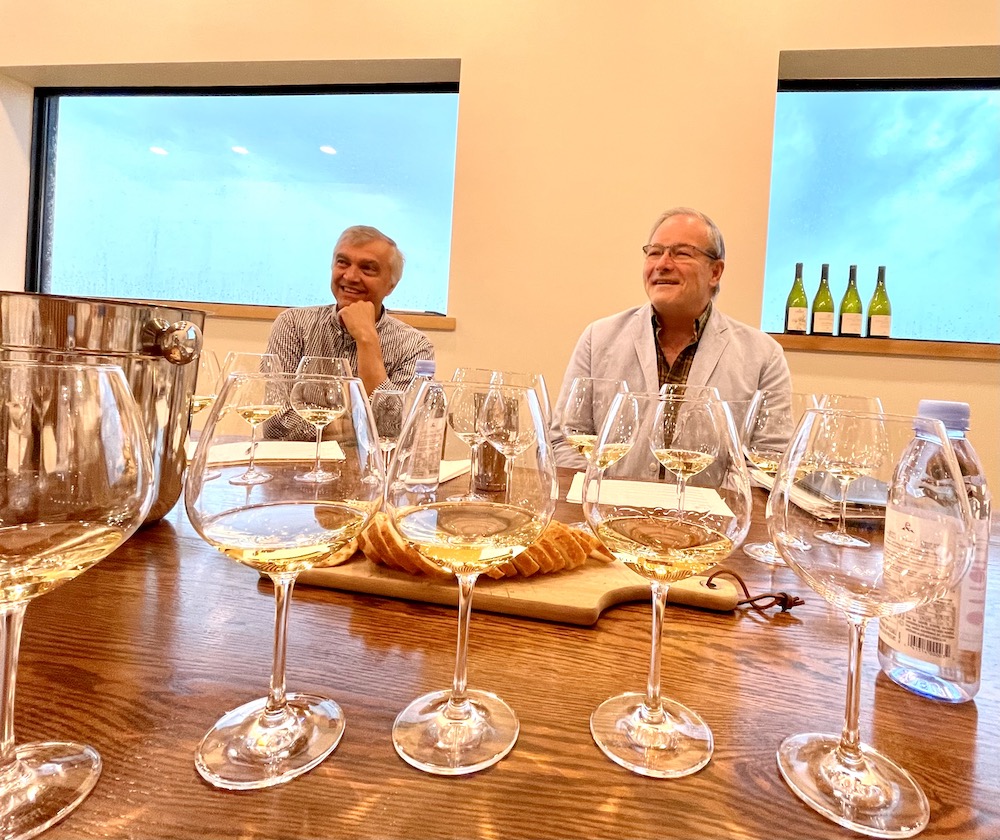
Niagara’s Lailey Winery has received a distinction of gold medal from a respected panel of international wine judges at the prestigious Chardonnay du Monde wine competition held in Burgundy, France claiming a top spot as one of the world’s top Chardonnay producers for its 2019 Stonebridge Chardonnay Reserve East. This wine was one of only three Canadian wines to receive this award, with the O’Rourke Family Estate Winery of Kelowna British Columbia and Two Sisters of Niagara-on-the-Lake picking up the other two gold awards.
Lailey and Stonebridge owner Matt (Faik) Turkmen said in a news release: “I am so thrilled for our entire team to have received such an esteemed award so early in our journey.” Turkmen believes the Niagara region, with its unique attributes and quality of soil and terroir, can take on any well-established wine region. “With hard work in the vineyards and patience in the cellars, our terroir allows us to produce wines that exceed the quality we used to see only from old world regions.”
Lailey is located in Niagara-on-the-Lake. The first vines were planted in the 1970s making Lailey one of the oldest wineries in the region. Recently merged with Stonebridge Vineyards, Lailey farms with low yields from the vineyard and minimum intervention in producing high quality, small batch wines.
Stonebridge is Lailey’s premium brand, displaying the true expression of its roots and terroir with a focus on Chardonnay and Cabernet Franc with specially selected clonal diversity.
The Chardonnay du Monde international competition
The Chardonnay du Monde international competition recognizes the world’s best Chardonnay wines by awarding them with reliable and representative medals. This competition is based on a single conviction: distinctive marks of quality are the key to real differentiation and therefore enhancing the value of the awarded wines in a highly competitive market. Here’s my review of the gold medal wine:
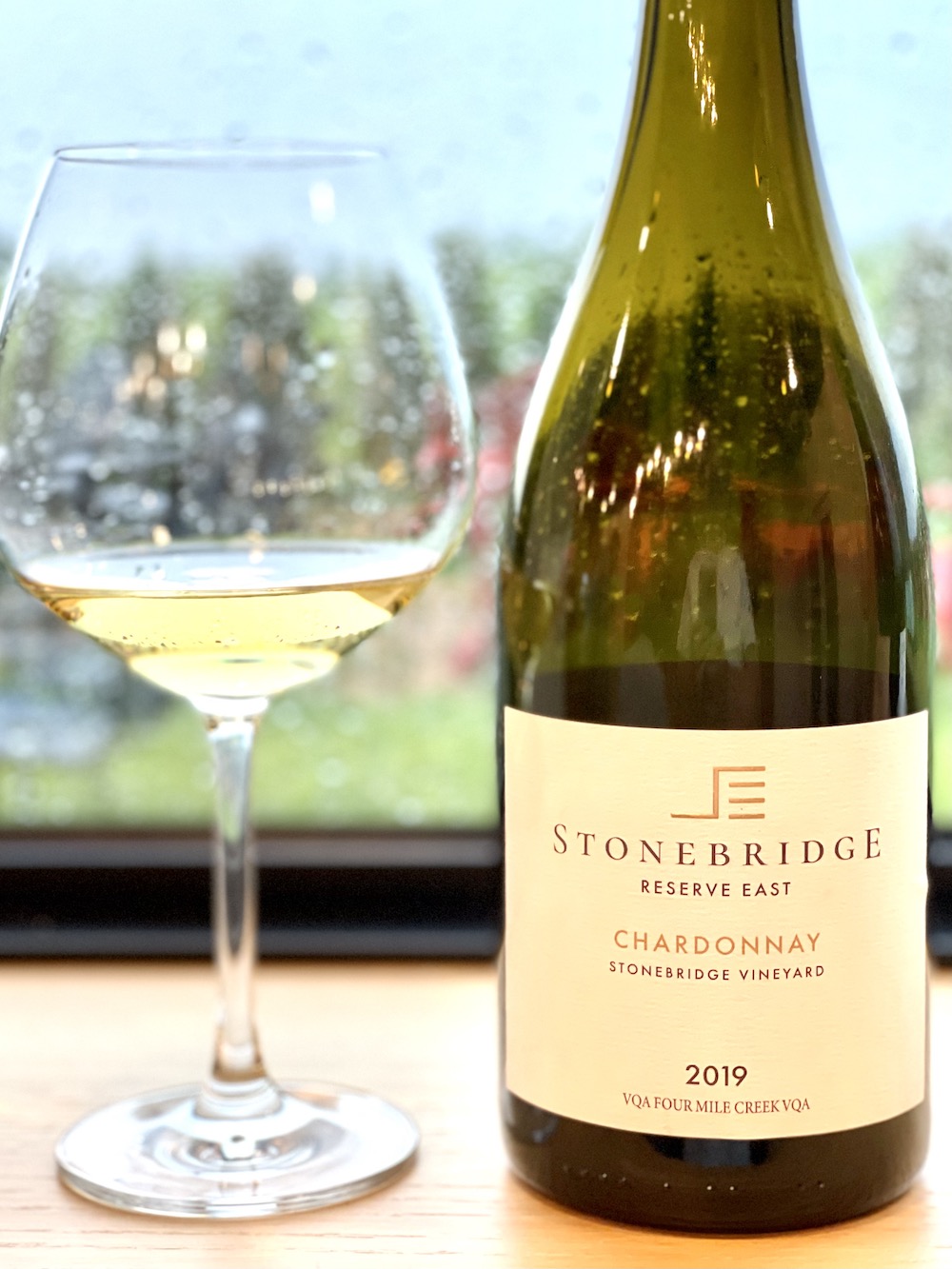
Stonebridge Chardonnay Reserve East 2019 ($78, 93 points) — This East version of the single-block Chards is equally intriguing as the west version. It’s a bit more delicate on the nose, more elegant and evolving, then bin apple, cream, bergamot, toasted hazelnuts, pear, beautiful oak spices and a floral note. It turns to a more textured style on the palate with a creamy feel to go with rich stone fruits, a chalky/flinty note, rich spices, and electric finesse on the long and vibrant finish. Just a beautiful Chardonnay.


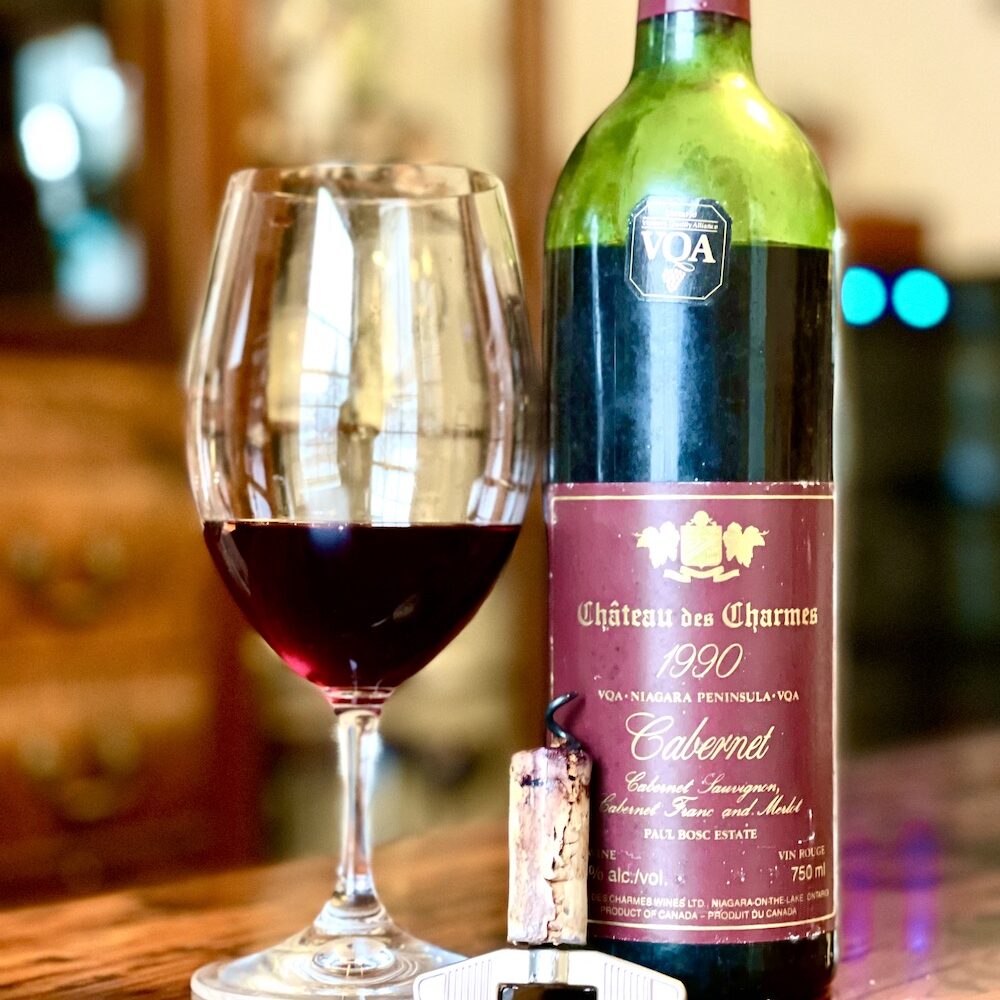



Comment here